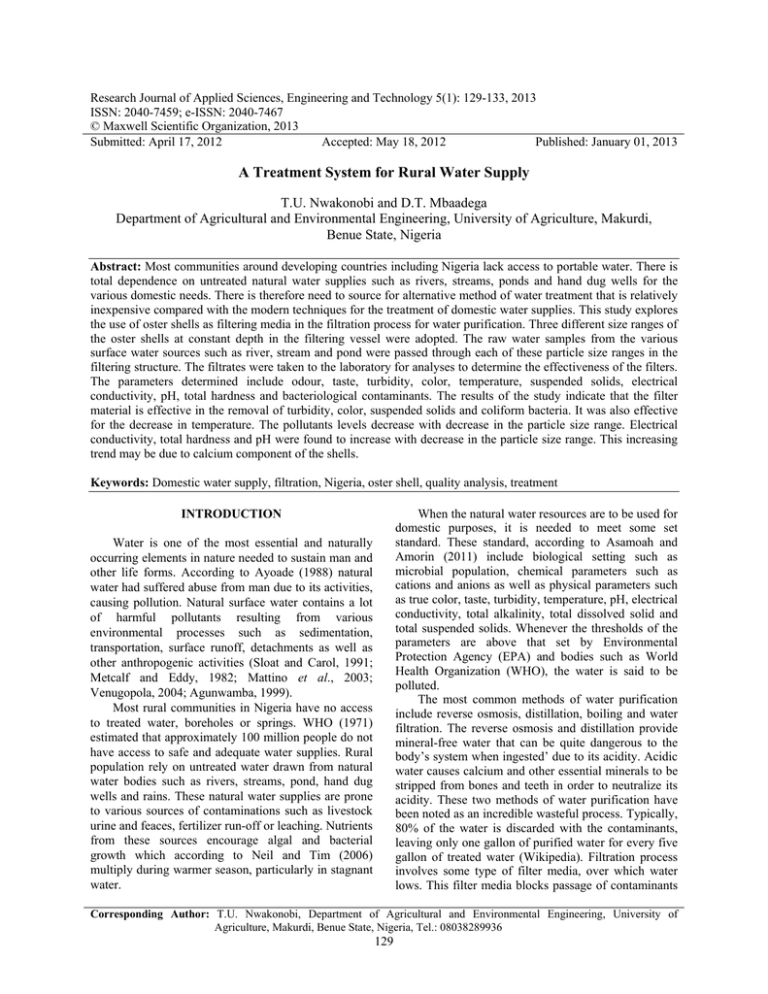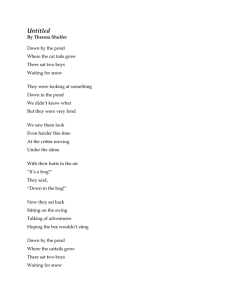Research Journal of Applied Sciences, Engineering and Technology 5(1): 129-133,... ISSN: 2040-7459; e-ISSN: 2040-7467
advertisement

Research Journal of Applied Sciences, Engineering and Technology 5(1): 129-133, 2013 ISSN: 2040-7459; e-ISSN: 2040-7467 © Maxwell Scientific Organization, 2013 Submitted: April 17, 2012 Accepted: May 18, 2012 Published: January 01, 2013 A Treatment System for Rural Water Supply T.U. Nwakonobi and D.T. Mbaadega Department of Agricultural and Environmental Engineering, University of Agriculture, Makurdi, Benue State, Nigeria Abstract: Most communities around developing countries including Nigeria lack access to portable water. There is total dependence on untreated natural water supplies such as rivers, streams, ponds and hand dug wells for the various domestic needs. There is therefore need to source for alternative method of water treatment that is relatively inexpensive compared with the modern techniques for the treatment of domestic water supplies. This study explores the use of oster shells as filtering media in the filtration process for water purification. Three different size ranges of the oster shells at constant depth in the filtering vessel were adopted. The raw water samples from the various surface water sources such as river, stream and pond were passed through each of these particle size ranges in the filtering structure. The filtrates were taken to the laboratory for analyses to determine the effectiveness of the filters. The parameters determined include odour, taste, turbidity, color, temperature, suspended solids, electrical conductivity, pH, total hardness and bacteriological contaminants. The results of the study indicate that the filter material is effective in the removal of turbidity, color, suspended solids and coliform bacteria. It was also effective for the decrease in temperature. The pollutants levels decrease with decrease in the particle size range. Electrical conductivity, total hardness and pH were found to increase with decrease in the particle size range. This increasing trend may be due to calcium component of the shells. Keywords: Domestic water supply, filtration, Nigeria, oster shell, quality analysis, treatment When the natural water resources are to be used for domestic purposes, it is needed to meet some set standard. These standard, according to Asamoah and Amorin (2011) include biological setting such as microbial population, chemical parameters such as cations and anions as well as physical parameters such as true color, taste, turbidity, temperature, pH, electrical conductivity, total alkalinity, total dissolved solid and total suspended solids. Whenever the thresholds of the parameters are above that set by Environmental Protection Agency (EPA) and bodies such as World Health Organization (WHO), the water is said to be polluted. The most common methods of water purification include reverse osmosis, distillation, boiling and water filtration. The reverse osmosis and distillation provide mineral-free water that can be quite dangerous to the body’s system when ingested’ due to its acidity. Acidic water causes calcium and other essential minerals to be stripped from bones and teeth in order to neutralize its acidity. These two methods of water purification have been noted as an incredible wasteful process. Typically, 80% of the water is discarded with the contaminants, leaving only one gallon of purified water for every five gallon of treated water (Wikipedia). Filtration process involves some type of filter media, over which water lows. This filter media blocks passage of contaminants INTRODUCTION Water is one of the most essential and naturally occurring elements in nature needed to sustain man and other life forms. According to Ayoade (1988) natural water had suffered abuse from man due to its activities, causing pollution. Natural surface water contains a lot of harmful pollutants resulting from various environmental processes such as sedimentation, transportation, surface runoff, detachments as well as other anthropogenic activities (Sloat and Carol, 1991; Metcalf and Eddy, 1982; Mattino et al., 2003; Venugopola, 2004; Agunwamba, 1999). Most rural communities in Nigeria have no access to treated water, boreholes or springs. WHO (1971) estimated that approximately 100 million people do not have access to safe and adequate water supplies. Rural population rely on untreated water drawn from natural water bodies such as rivers, streams, pond, hand dug wells and rains. These natural water supplies are prone to various sources of contaminations such as livestock urine and feaces, fertilizer run-off or leaching. Nutrients from these sources encourage algal and bacterial growth which according to Neil and Tim (2006) multiply during warmer season, particularly in stagnant water. Corresponding Author: T.U. Nwakonobi, Department of Agricultural and Environmental Engineering, University of Agriculture, Makurdi, Benue State, Nigeria, Tel.: 08038289936 129 Res. J. Appl. Sci., Engine. Technol., 5(1): 129-133, 2013 through physical obstruction, chemical absorption or a combination of both processes (Wikipedia). In this study the effects of locally available material such as oster shells as filter media for natural water treatment was investigated. MATERIALS AND METHODS This study was conducted at the Department of Agricultural and Environmental Engineering, University of Agriculture, Makurdi, Benue State, Nigeria, in 2007. Materials used: The filtering material used was the oster shells of sea animal (periwinkle) obtained as waste material. Raw water obtained from various surface water sources which included river water, stream and pond in the study area was used for the test. Preparation of filtering material: Oster shells were crushed and grinded. The grinded shell samples were passed through sieves or mesh of various size openings in other to get coarse, fine and very fine size ranges. The particle size range of 2.00-3.00, 0.85-1.90 and 0.43-0.65 mm as coarse, less coarse and fine range, respectively were obtained. The material samples were properly washed to remove all dirt and dusty particles as well as other contaminants present in the filtering materials. The filtering structure: The filtering structure consists of three closed top plastic chambers or vessels of 0.011 m3 (or 11 L) each in volume. The arrangement of the plastic chambers is as shown in Fig. 1. Each chamber was provided with self supporting under-drain system grouted to the filter floor. A pipe of 15 mm in diameter was connected from and to each of the vessels by means of fasteners and adhesive substance to prevent water leakage. The pipes were provided with screen at both ends to prevent passage of fine particles that may result in blockage of the pipe and prevent free water flow. The vessel chambers were rigidly mounted on steel frames of different height to enable water flow by gravity from vessel at higher elevation to that at lower level. The first two chambers from highest elevation were fitted with taps at their bottoms for collection of filtrate from each of them. The third or lowest elevated vessel or chamber is fitted with regulator to regulate the flow of the final filtrate. The testing procedure: The three plastic chambers were filled with the filtering materials (oster shell) to a uniform depth of 180 mm each. Each of the three chambers designated as A, B and C contains the particle size range of 2.00-3.00, 0.85-1-90 and 0.43-0.65 mm, respectively. Raw water samples drawn from river, stream and pond water sources were tested. About 0.0046 m3 or 4.6 L of water sample from each of the sources were poured into chamber, A and the filtrate passing through the filter and pipe to the next chamber, B from where it is passed to the chamber C from where, the filtrate was collected. During the process, filtrates were also collected from chambers A and B through the Fig. 1: The filtering structure 130 Res. J. Appl. Sci., Engine. Technol., 5(1): 129-133, 2013 bottom taps. The final filtrate was then collected after passing through the filter bed in chamber C. The same filtration process was carried out for river, stream and pond water samples. The filtrates collected were subjected to laboratory analysis to establish the effectiveness of the filtering material in treating the rural water sources. Raw water samples from river, stream and pond were also subjected to analysis in order to compare the results with that of the filtrate. The characteristics of each water sample tested include temperature, odour, taste, turbidity, color, suspended solids total hardness, pH, electrical conductivity and bacteriological contaminations. The odour and taste of the water samples were evaluated subjectively using a 12 member semi trained panel and the standard procedure on water analysis as specified by NAFDAC. The temperature was measured by use of a probe instrument. The turbidity and Total Suspended Solid (TSS) of the samples were determined with the hach portable colorimeter (Model DR/350) as described by APHA (1998). Color was measured by platinum-cobalt standard method. Total hardness was determined by the Ethylenediamine Tetra Acetic acid (EDTA) titrimetric method as described by APHA (1998). The pH was determined using standard method after Clesceri et al. the electrical conductivity (1989), while was determined using a conductivity meter as described by APHA (1998). The microbial quality of the water samples were determined by using total coliform count as indices. The total coliform count was determined on each sample by plating presumptive positive samples on Mac Conkay agar. Incubation was done at 37°C for 48 h. RESULTS AND DISCUSSION Results: The concentration level of physical, chemical and biological parameters obtained for both the raw water and the filtrate samples of the various water sources are presented in Table 1-3. The characteristics of river water before and after filtration are presented in Table 1. Table 2 shows the result of the analyses of stream water (Ahom stream) as it was filtrated from chamber A to C through chamber B. The results of the determination of physical, chemical and biological parameters of pond water before and after filtration are presented in Table 3. Discussion: The results of the analysis shown in Table 1-3 indicate that both odour and taste of raw water and filtrate samples are all unobjectionable for all the surface water sources. The results also show that river water has the highest turbidity level, 300 NTU and decrease down to 106 NTU as it was passed through the Table 1: Characteristics of river water before and after filtration Parameter Odour Taste Turbidity (NTU) Color Temp (°C) Suspended solids (Mg/L) Electrical conductivity ( s) pH Total hardness (mg/L) No. of coliform/100 mL of H20 at 37°C Raw water Unobjectionable Unobjectionable 300.00 550.00 30.10 170.00 61.80 7.10 120.00 5+ve Filtrate ----------------------------------------------------------------------------------------Chamber A Chamber B Chamber C Unobjectionable Unobjectionable Unobjectionable Unobjectionable Unobjectionable Unobjectionable 196.0 125.0 106.00 540.0 530.0 500.00 29.6 29.5 29.40 150.0 110.0 91.00 148.0 166.5 468.00 72.0 7.3 7.40 140.0 180.0 220.00 5+ve 5+ve 5+ve Table 2: Characteristics of stream water before and after filtration Parameter Odour Taste Turbidity (NTU) Color Temp (°C) Suspended solids (Mg/L) Electrical conductivity ( s) pH Total hardness (mg/L) No. of coliform/100 mL of H20 at 37°C Raw water Unobjectionable Unobjectionable 292.0 550.0 29.8 135.0 100.5 7.1 200.0 5+ve Filtrate ----------------------------------------------------------------------------------------Chamber A Chamber B Chamber C Unobjectionable Unobjectionable Unobjectionable Unobjectionable Unobjectionable Unobjectionable 160.0 98.0 92.0 494.0 490.0 466.0 29.4 29.1 29.0 120.0 95.0 35.0 171.4 183.9 392.0 7.4 7.6 7.8 260.0 300.0 320.0 5+ve 5+ve 4+ve 131 Res. J. Appl. Sci., Engine. Technol., 5(1): 129-133, 2013 Table 3: Characteristics of pond water before and after filtration Parameter Odour Taste Turbidity (NTU) Color Temp (°C) Suspended solids (Mg/L) Electrical conductivity ( s) pH Total hardness (mg/L) No. of coliform/100 mL of H20 at 37°C Raw water Unobjectionable Unobjectionable 180.0 546.0 30.2 51.0 93.6 7.0 100.0 5+ve three chambers containing filtering material of various size ranges. This is followed by the stream water with turbidity decreasing from 292 to 92 NTU and pond water from 180 to 61 NTU. These values do not fall within the acceptable value provided by WHO of 5 and 1.5 unit by U.S.A. The raw water samples from all the surface sources had color. But the color intensity was reduced as the water samples were filtrated from chamber A to C through chamber B. The filtering materials had little effect on the color of water samples from all the sources. The color unit of final filtrate sample did not fall within the acceptable limit of 5-15 TCU as recommended by (WHO, NAFDAC and NPDWR). The reason for this could be attributed to the debris and colloidal particles carried by runoff into the surface water body. It could also be attributed to dumping of refuse directly into the water body. The temperature of river Benue water sample decreased from 30.1 to 29.4°C while that of stream water decreased from 29.8 to 29°C. The temperature of pond water decreased from 30.2 to 29°C. According to Venugopola (2004) palatability, solubility, viscosity, chemical reactions and odour are influenced by temperature. The concentration values of the total suspended solid were found to decrease from 170 to 91 mg/L for river water, 135 to 35 mg/L for Ahom stream water and 51 to 43 mg/L for pond water. The presence of suspended solid can be attributed to materials from trees such as leaves and debris from runoff. The electrical conductivity value obtained from three samples of surface water indicates that river Benue water increased from 61.8 to 468 , Ahum stream water increased from 100.5to 392.0 and pond water increased from 93.6 to 322 The pH of the three samples of water sources change slightly from 7.1 to 7.4 for river water, 7.1 to 7.8 for Ahum stream and 7.0 to 7.5 for pond water. The pH values obtained fall within the acceptable range recommended by WHO, U.S.A. and NAFDAC for domestic uses. The increase in the alkalinity of water quality may be as a result of the calcium content of the filtering materials (Venugopola, 2004). The value obtained for the total hardness increased from 140 to 220 mg/L for river water, 200 to 320 mg/L Filtrate ----------------------------------------------------------------------------------------Chamber A Chamber B Chamber C Unobjectionable Unobjectionable Unobjectionable Unobjectionable Unobjectionable Unobjectionable 100.0 82.0 61.0 490.0 481.0 442.0 29.3 29.2 29.0 47.0 45.0 43.0 151.6 176.9 326.0 7.2 7.4 7.5 140.0 180.0 200.0 5+ve 5+ve 4+ve for Ahum stream water and 100 to 200 mg/L for pond water. These values fall within the acceptable limit (250 to 500 mg/L) by WHO and NAFDAC. The increase in hardness may be as a result of calcium component of the oster shell (Venugopola, 2004). The presence of coliform bacteria was indicated in all the water samples which is an indicator of the possibility of contamination by pathogenic agents or presence of human or animal fecal waste contamination of the water source (Inspect APedia.com). Only small quantity of bacteria were filtered out and dropped on the surface of the shells. CONCLUSION The oster shells used as filtering material improves the water quality of the three surface water sources (River Benue, Ahum stream and pond water) tested. There was reduction in the total suspended solid of the filtrate by 65, 69 and 66% for river, stream and pond water, respectively. Color intensity of the final filtrate was reduced by 20, 15 and 1% for river, stream and pond water, respectively. Total suspended solid of the river, stream and pond was reduced by 47, 74 and 16%, respectively. While the electrical conductivity of the water samples was increased by 657, 290 and 248% for river, stream and pond, respectively. Similarly, the total hardness of river water was increased by 83%; stream water, 60%; and pond, 100%. There was small reduction in coliform bacteria count for all the water sources tested. The quality of water samples from the three sources tested also improves as the particle size range of the filter material decreases. It is therefore recommended that this low-cost and simple filter be used in rural areas where modern treatment plants do not exist. The effects of increasing the depth of the filter media on improving the quality of the rural water supplies should further be investigated. To meet the World Health Organization (WHO) standard for potable water, the filtrate should be disinfected with chlorine to remove all the coliform bacteria. 132 Res. J. Appl. Sci., Engine. Technol., 5(1): 129-133, 2013 REFERENCES Agunwamba, J.C., 1999. Water Engineering Systems. Immaculate Publishers Ltd., Enugu. APHA, 1998. Standard Methods for the Examination of Water and Waste Water. American Public Health Association, Washington, D.C. Asamoah, D.N. and R. Amorin, 2011. Assessment of the quality of Bottled/Satchet water in the TarkwaNsuaem Municipality (TM) of Ghana Maxwell Scientific Organization. Res. J. Appl. Sci., Eng. Technol., 3(5): 377-385. Ayoade, J.O., 1988. Tropical Hydrology and water Resources. Macmillan Publishers Ltd., London, pp: 189-214. Clesceri, L.S., A.E. Greenberg and R.R. Trussell, 1989. Standard Methods for the Examination of Water and Waste Water. 17th Edn., American Public Health Association, Washington DC., USA., pp: 1-175. Mattino, M.J.I, W.I. Berger, C. Musante and I.C. White, 2003. Concurrent Plants uptake of heavy metals and persistent organic pollutants from soil. Environ. Pollut., 124: 375-378. Metcalf and I. Eddy, 1982. Water Engineering Treatment: Disposal and Refuse. 2nd Edn., Teta McGraw-Hill Publishing Co. Ltd., London. Neil, L. and C. Tim, 2006. Tarmnote: Water Quality for Farm, Garden and Household use. Department of Agriculture, Western Australia, No. 41/2004. Sloat and Z. Carol, 1991. The use of Indicator Organism to Asses Public Water Safety. Hach Technical Centre for Applied Analytical Chemistry, Colorado, U.S.A. Venugopola, R.P., 2004. Text Book of Environmental Engineering. Prentice Hall of India Private Ltd., Newe Delhi. WHO, 1971. International Standard for Drinking Water. 3rd Edn., World Health Organization, USA. 133




